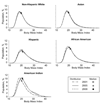Disparities in peaks, plateaus, and declines in prevalence of high BMI among adolescents
- PMID: 20713482
- PMCID: PMC3013279
- DOI: 10.1542/peds.2009-3411
Disparities in peaks, plateaus, and declines in prevalence of high BMI among adolescents
Abstract
Objectives: The objective of this study was to investigate trends in prevalence of high BMI from 2001 to 2008 and examine racial/ethnic disparities.
Methods: Records for a total of 8 283 718 fifth-, seventh-, and ninth-grade students who underwent California's school-based BMI screening between 2001 and 2008 were included. Logistic regression identified trends in prevalence of high BMI (>or=85th, >or=95th, >or=97th, and >or=99th percentiles).
Results: For 3 of 4 BMI cut points, prevalence continued to increase for black and American Indian girls through 2008, Hispanic girls plateaued after 2005, non-Hispanic white girls declined to 2001 prevalence levels after peaking in 2005, and Asian girls showed no increases. Non-Hispanic white boys peaked in 2005, then declined to 2001 prevalence levels for all BMI cut points; Hispanic and Asian boys declined after 2005 (for 3 lowest BMI cut points only) but remained above 2001 levels; and American Indian boys peaked later (2007) and declined only for BMI>or=95th. No girls and few boys showed a decline after peaking in prevalence of BMI>or=99th percentile. In 2008, disparities in prevalence were greatest for BMI>or=99th percentile, with prevalence of 4.9% for American Indian girls and 4.6% for black girls versus 1.3% for non-Hispanic white girls.
Conclusions: On the basis of statewide California data, prevalence of high BMI is declining for some groups but has not declined for American Indian and black girls. These trends portend greater disparities over time, particularly in severe obesity. Interventions and policies that are tailored to the highest risk groups should be pursued.
Conflict of interest statement
No conflicts of interest.
Figures



Comment in
-
The role of pediatricians in the coordinated national effort to address childhood obesity.Pediatrics. 2010 Sep;126(3):574-5. doi: 10.1542/peds.2010-1873. Epub 2010 Aug 16. Pediatrics. 2010. PMID: 20713481 No abstract available.
References
-
- Jolliffe D. Extent of overweight among US children and adolescents from 1971 to 2000. Int J Obes Relat Metab Disord. 2004;28(1):4–9. - PubMed
-
- Ogden CL, Carroll MD, Curtin LR, Lamb MM, Flegal KM. Prevalence of high body mass index in US children and adolescents, 2007–2008. Jama. 2010;303(3):242–249. - PubMed
-
- Bibbins-Domingo K, Coxson P, Pletcher MJ, Lightwood J, Goldman L. Adolescent overweight and future adult coronary heart disease. N Engl J Med. 2007;357(23):2371–2379. - PubMed
-
- Freedman DS, Khan LK, Serdula MK, Dietz WH, Srinivasan SR, Berenson GS. The relation of childhood BMI to adult adiposity: the Bogalusa Heart Study. Pediatrics. 2005;115(1):22–27. - PubMed
Publication types
MeSH terms
Grants and funding
LinkOut - more resources
Full Text Sources
Medical

